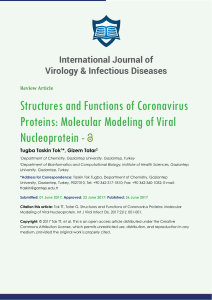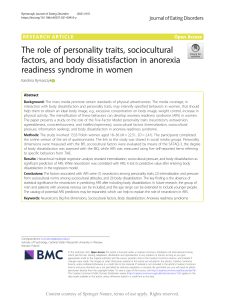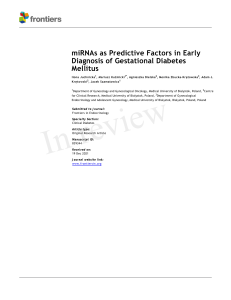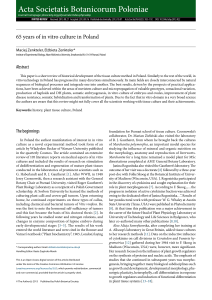Uploaded by
common.user512
Heat death of the universe
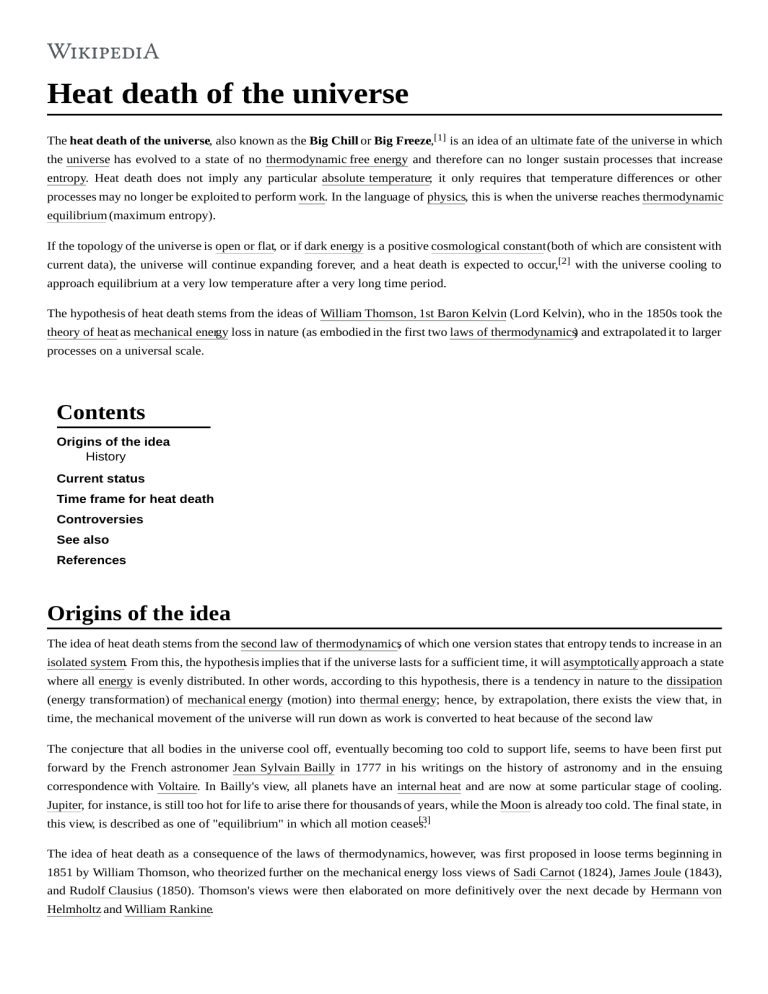
Heat death of the universe The heat death of the universe, also known as the Big Chill or Big Freeze,[1] is an idea of an ultimate fate of the universe in which the universe has evolved to a state of no thermodynamic free energy and therefore can no longer sustain processes that increase entropy. Heat death does not imply any particular absolute temperature; it only requires that temperature differences or other processes may no longer be exploited to perform work. In the language of physics, this is when the universe reaches thermodynamic equilibrium (maximum entropy). If the topology of the universe is open or flat, or if dark energy is a positive cosmological constant (both of which are consistent with current data), the universe will continue expanding forever, and a heat death is expected to occur,[2] with the universe cooling to approach equilibrium at a very low temperature after a very long time period. The hypothesis of heat death stems from the ideas of William Thomson, 1st Baron Kelvin (Lord Kelvin), who in the 1850s took the theory of heat as mechanical energy loss in nature (as embodied in the first two laws of thermodynamics) and extrapolated it to larger processes on a universal scale. Contents Origins of the idea History Current status Time frame for heat death Controversies See also References Origins of the idea The idea of heat death stems from the second law of thermodynamics, of which one version states that entropy tends to increase in an isolated system. From this, the hypothesis implies that if the universe lasts for a sufficient time, it will asymptotically approach a state where all energy is evenly distributed. In other words, according to this hypothesis, there is a tendency in nature to the dissipation (energy transformation) of mechanical energy (motion) into thermal energy; hence, by extrapolation, there exists the view that, in time, the mechanical movement of the universe will run down as work is converted to heat because of the second law . The conjecture that all bodies in the universe cool off, eventually becoming too cold to support life, seems to have been first put forward by the French astronomer Jean Sylvain Bailly in 1777 in his writings on the history of astronomy and in the ensuing correspondence with Voltaire. In Bailly's view, all planets have an internal heat and are now at some particular stage of cooling. Jupiter, for instance, is still too hot for life to arise there for thousands of years, while the Moon is already too cold. The final state, in [3] this view, is described as one of "equilibrium" in which all motion ceases. The idea of heat death as a consequence of the laws of thermodynamics, however, was first proposed in loose terms beginning in 1851 by William Thomson, who theorized further on the mechanical energy loss views of Sadi Carnot (1824), James Joule (1843), and Rudolf Clausius (1850). Thomson's views were then elaborated on more definitively over the next decade by Hermann von Helmholtz and William Rankine. History The idea of heat death of the universe derives from discussion of the application of the first two laws of thermodynamics to universal processes. Specifically, in 1851, William Thomson outlined the view, as based on recent experiments on the dynamical theory of heat: "heat is not a substance, but a dynamical form of mechanical effect, we perceive that there must be an equivalence between mechanical work and heat, as between cause and ef fect."[4] In 1852, Thomson published On a Universal Tendency in Nature to the Dissipation of Mechanical Energy, in which he outlined the rudiments of the second law of thermodynamics summarized by the view that mechanical motion and the energy used to create that motion will naturally tend to dissipate or run down.[5] The ideas in this paper, in relation to their application to the age of the Sun and the dynamics of the universal operation, attracted the likes of William Rankine and Hermann von Helmholtz. The three of them were said to have exchanged ideas on this subject.[6] In 1862, Thomson published "On the age of the Sun’s heat", an article in which he reiterated his fundamental beliefs in the indestructibility of energy (the first law) and the universal dissipation of energy (the second law), leading to diffusion of heat, cessation of useful motion (work), and exhaustion of potential energy through the material universe, while clarifying his view of the consequences for the universe as a whole. In a key paragraph, Thomson wrote: The result would inevitably be a state of universal rest and death, if the Lord Kelvin originated the idea of universal heat death in 1852. universe were finite and left to obey existing laws. But it is impossible to conceive a limit to the extent of matter in the universe; and therefore science points rather to an endless progress, through an endless space, of action involving the transformation of potential energy into palpable motion and hence into heat, than to a single finite mechanism, running down like a clock, and stopping for ever.[7] In the years to follow both Thomson's 1852 and the 1865 papers, Helmholtz and Rankine both credited Thomson with the idea, but read further into his papers by publishing views stating that Thomson argued that the universe will end in a "heat death" (Helmholtz) which will be the "end of all physical phenomena" (Rankine).[6][8] Current status Proposals about the final state of the universe depend on the assumptions made about its ultimate fate, and these assumptions have varied considerably over the late 20th century and early 21st century. In a hypothesized "open" or "flat" universe that continues expanding indefinitely, either a heat death or a Big Rip is expected to eventually occur.[2] If the cosmological constant is zero, the universe will approach absolute zero temperature over a very long timescale. However, if the cosmological constant is positive, as appears to be the case in recent observations, the temperature will asymptote to a non-zero positive value, and the universe will approach a state of maximum entropy in which no further work is possible.[9] If a Big Rip does not happen long before that, the "heat death" situation could be avoided if there is a method or mechanism to regenerate hydrogen atoms from radiation, dark matter, dark energy, zero-point energy, or other sources so that star formation and heat transfer can continue to avoid a gradual running down of the universe due to the conversion of matter into energy and heavier elements in stellar processes and the absorption of matter by black holes and their subsequent evaporation as Hawking radiation.[10][11] Time frame for heat death From the Big Bang through the present day, matter and dark matter in the universe are thought to have been concentrated in stars, galaxies, and galaxy clusters, and are presumed to continue to be so well into the future. Therefore, the universe is not in thermodynamic equilibrium, and objects can do physical work.[12], §VID. The decay time for a supermassive black hole of roughly 1 galaxy mass (1011 solar masses) due to Hawking radiation is on the order of 10100 years,[13] so entropy can be produced until at least that time. Some monster black holes in the universe are predicted to continue to grow up to perhaps 1014 M☉ during the collapse of superclusters of galaxies. Even these would evaporate over a timescale of up to 10106 years.[14] After that time, the universe enters the so-called Dark Era and is expected to consist chiefly of a dilute gas of photons and leptons.[12]§VIA With only very diffuse matter remaining, activity in the universe will have tailed off dramatically, with extremely low energy levels and extremely long timescales. Speculatively, it is possible that the universe may enter a second inflationary epoch, or assuming that the current vacuum state is a false vacuum, the vacuum may decay into a lower-energy state.[12], §VE. It is also possible that entropy production will cease and the universe will reach heat death.[12], §VID. Another universe could possibly be created by random quantum fluctuations or quantum tunneling in roughly years.[15] Over vast periods of time, a spontaneous entropy decrease would eventually occur via the Poincaré recurrence theorem, thermal fluctuations,[16][17][18] and fluctuation theorem.[19][20] Such a scenario, however, has been described as "highly speculative, probably wrong, [and] completely untestable".[21] Sean M. Carroll, originally an advocate of this idea, no longer supports it.[22][23] Controversies Max Planck wrote that the phrase "entropy of the universe" has no meaning because it admits of no accurate definition.[24][25] More recently, Grandy writes: "It is rather presumptuous to speak of the entropy of a universe about which we still understand so little, and we wonder how one might define thermodynamic entropy for a universe and its major constituents that have never been in equilibrium in their entire existence."[26] According to Tisza: "If an isolated system is not in equilibrium, we cannot associate an entropy with it."[27] Buchdahl writes of "the entirely unjustifiable assumption that the universe can be treated as a closed thermodynamic system".[28] According to Gallavotti: "... there is no universally accepted notion of entropy for systems out of equilibrium, even when in a stationary state."[29] Discussing the question of entropy for non-equilibrium states in general, Lieb and Yngvason express their opinion as follows: "Despite the fact that most physicists believe in such a nonequilibrium entropy, it has so far proved impossible to define it in a clearly satisfactory way."[30] In Landsberg's opinion: "The third misconception is that thermodynamics, and in particular, the concept of entropy, can without further enquiry be applied to the whole universe. ... These [31] questions have a certain fascination, but the answers are speculations, and lie beyond the scope of this book." A recent analysis of entropy states, "The entropy of a general gravitational field is still not known", and, "gravitational entropy is difficult to quantify". The analysis considers several possible assumptions that would be needed for estimates and suggests that the observable universe has more entropy than previously thought. This is because the analysis concludes that supermassive black holes are the largest contributor.[32] Lee Smolin goes further: "It has long been known that gravity is important for keeping the universe out of thermal equilibrium. Gravitationally bound systems have negative specific heat—that is, the velocities of their components increase when energy is removed. ... Such a system does not evolve toward a homogeneous equilibrium state. Instead it becomes [33] increasingly structured and heterogeneous as it fragments into subsystems." See also Arrow of time Big Bang Big Bounce Big Crunch Big Rip Chronology of the universe Cyclic model Entropy (arrow of time) Fluctuation theorem Graphical timeline from Big Bang to Heat Death Heat death paradox The Last Question Timeline of the far future Orders of magnitude (time) Thermodynamic temperature References 1. WMAP – Fate of the Universe(http://map.gsfc.nasa.gov/universe/uni_fate.html) , WMAP's Universe, NASA. Accessed online July 17, 2008. 2. Plait, Philip (2008). Death from the Skies!. Viking Adult (published 16 October 2008). p. 259. ISBN 978-0-670-019977. 3. Brush, Stephen G. (1996). A History of Modern Planetary Physics: Nebulous Earth . 1. Cambridge University Press. p. 77. ISBN 978-0-521-44171-1. 4. Thomson, Sir William. (1851)."On the Dynamical Theory of Heat, with numerical results deduced from Mr Joule’ s equivalent of a Thermal Unit, and M. Regnault’ s Observations on Steam"(https://zapatopi.net/kelvin/papers/on_the_ dynamical_theory_of_heat.html)Excerpts. [§§1–14 & §§99–100],Transactions of the Royal Society of Edinburgh, March 1851, and Philosophical Magazine IV, 1852. [from Mathematical and Physical Papers, vol. i, art. XLVIII, pp. 174] 5. Thomson, Sir William (1852)."On a Universal Tendency in Nature to the Dissipation of Mechanical Energy"(https://z apatopi.net/kelvin/papers/on_a_universal_tendency .html) Proceedings of the Royal Society of Edinburghfor 19 April 1852, also Philosophical Magazine, Oct. 1852. [This version fromMathematical and Physical Papers, vol. i, art. 59, pp. 511.] 6. Smith, Crosbie; Wise, M. Norton (1989). Energy and Empire: A Biographical Study of Lord Kelvin . Cambridge University Press. p. 500.ISBN 978-0-521-26173-9. 7. Thomson, Sir William (5 March 1862)."On the Age of the Sun's Heat"(https://zapatopi.net/kelvin/papers/on_the_age _of_the_suns_heat.html). Macmillan's Magazine. Vol. 5. pp. 388–93. 8. "Physics Chronology" (https://web.archive.org/web/20110522124507/http://webplaza.pt.lu/fklaess/html/HIST ORIA.H TML). Archived from the original (http://webplaza.pt.lu/fklaess/html/HISTORIA.HTML) on 22 May 2011. 9. Dyson, Lisa; Kleban, Matthew; Susskind, Leonard (12 November 2002). "Disturbing Implications of a Cosmological Constant". Journal of High Energy Physics. 2002 (10): 011. arXiv:hep-th/0208013 (https://arxiv.org/abs/hep-th/02080 13). Bibcode:2002JHEP...10..011D (http://adsabs.harvard.edu/abs/2002JHEP ...10..011D). doi:10.1088/11266708/2002/10/011 (https://doi.org/10.1088%2F1126-6708%2F2002%2F10%2F011) . 10. MacMillan, William Duncan(July 1918). "On Stellar Evolution".The Astrophysical Journal. 48: 35–49. Bibcode:1918ApJ....48...35M (http://adsabs.harvard.edu/abs/1918ApJ....48...35M) . doi:10.1086/142412 (https://doi.o rg/10.1086%2F142412). 11. Macmillan, William D. (31 July 1925). "Some Mathematical Aspects of Cosmology".Science. 62 (1596): 96–9. Bibcode:1925Sci....62..121M (http://adsabs.harvard.edu/abs/1925Sci....62..121M) . doi:10.1126/science.62.1596.96 (https://doi.org/10.1126%2Fscience.62.1596.96) . PMID 17752724 (https://www.ncbi.nlm.nih.gov/pubmed/17752724). 12. Adams, Fred C.; Laughlin, Gregory (1997). "A dying universe: the long-term fate and evolution of astrophysical objects". Reviews of Modern Physics. 69 (2): 337–72. arXiv:astro-ph/9701131 (https://arxiv.org/abs/astro-ph/970113 1). Bibcode:1997RvMP...69..337A (http://adsabs.harvard.edu/abs/1997RvMP ...69..337A). doi:10.1103/RevModPhys.69.337(https://doi.org/10.1103%2FRevModPhys.69.337) . 13. See in particular equation (27) inPage, Don N. (15 January 1976). "Particle emission rates from a black hole: Massless particles from an uncharged, nonrotating hole".Physical Review D. 13 (2): 198–206. Bibcode:1976PhRvD..13..198P (http://adsabs.harvard.edu/abs/1976PhRvD..13..198P) . doi:10.1103/PhysRevD.13.198(https://doi.org/10.1103%2FPhysRevD.13.198) . 14. Frautschi, Steven (13 August 1982)."Entropy in an Expanding Universe"(http://www.informationphilosopher.com/sol utions/scientists/layzer/Frautschi_Science_1982.pdf)(PDF). Science. 217 (4560): 593–9. Bibcode:1982Sci...217..593F (http://adsabs.harvard.edu/abs/1982Sci...217..593F) . doi:10.1126/science.217.4560.593(https://doi.org/10.1126%2Fscience.217.4560.593) . JSTOR 1688892 (https://ww w.jstor.org/stable/1688892). PMID 17817517 (https://www.ncbi.nlm.nih.gov/pubmed/17817517). "Since we have assumed a maximum scale of gravitational binding—for instance, superclusters of galaxies—black hole formation 14M ... the timescale for black holes to radiate eventually comes to an end in our model, with masses of up to 10 ☉ away all their energy ranges ... to 10106 years for black holes of up to 1014M☉" 15. Carroll, Sean M.; Chen, Jennifer (October 2004). "Spontaneous Inflation and Origin of the Arrow ofime". T arXiv:hepth/0410270 (https://arxiv.org/abs/hep-th/0410270).Bibcode: 2004hep.th...10270C (http://adsabs.harvard.edu/abs/200 4hep.th...10270C) 16. Tegmark, Max (2003). "Parallel Universes".Scientific American. 288 (2003): 40–51. arXiv:astro-ph/0302131 (https:// arxiv.org/abs/astro-ph/0302131). Bibcode:2003SciAm.288e..40T (http://adsabs.harvard.edu/abs/2003SciAm.288e..4 0T). doi:10.1038/scientificamerican0503-40(https://doi.org/10.1038%2Fscientificamerican0503-40) . 17. Tegmark, Max (May 2003). "Parallel Universes".Scientific American. 288 (5): 40–51. arXiv:astro-ph/0302131 (https:// arxiv.org/abs/astro-ph/0302131). Bibcode:2003SciAm.288e..40T (http://adsabs.harvard.edu/abs/2003SciAm.288e..4 0T). doi:10.1038/scientificamerican0503-40(https://doi.org/10.1038%2Fscientificamerican0503-40) . 18. Werlang, T.; Ribeiro, G. A. P.; Rigolin, Gustavo (2013). "Interplay between quantum phase transitions and the behavior of quantum correlations at finite temperatures.org".International Journal of Modern Physics B. 27 (1n03): 1345032. arXiv:1205.1046 (https://arxiv.org/abs/1205.1046). Bibcode:2013IJMPB..2745032W(http://adsabs.harvard. edu/abs/2013IJMPB..2745032W). doi:10.1142/S021797921345032X(https://doi.org/10.1142%2FS02179792134503 2X). 19. Xiu-San Xing (1 November 2007). "Spontaneous entropy decrease and its statistical formula". arXiv:0710.4624 (http s://arxiv.org/abs/0710.4624) [cond-mat.stat-mech (https://arxiv.org/archive/cond-mat.stat-mech)]. 20. Linde, Andrei (2007). "Sinks in the landscape, Boltzmann brains and the cosmological constant problem". Journal of Cosmology and Astroparticle Physics. 2007 (1): 022. arXiv:hep-th/0611043 (https://arxiv.org/abs/hep-th/0611043). Bibcode:2007JCAP...01..022L (http://adsabs.harvard.edu/abs/2007JCAP ...01..022L). CiteSeerX 10.1.1.266.8334 (htt ps://citeseerx.ist.psu.edu/viewdoc/summary?doi=10.1.1.266.8334) . doi:10.1088/1475-7516/2007/01/022(https://doi. org/10.1088%2F1475-7516%2F2007%2F01%2F022) . 21. Pimbblet, Kevin (3 September 2015)."The fate of the universe: heat death, Big Rip or cosmic consciousness?" (http s://theconversation.com/the-fate-of-the-universe-heat-death-big-rip-or-cosmic-consciousness-46157) . The Conversation. 22. Carroll, Sean (27 January 2014). Sean Carroll, "Fluctuations in de Sitter Space" FQXi conference 2014 in ieques V (h ttps://www.youtube.com/watch?v=o-qqeDUU7HM). FQXi. 23. Boddy, Kimberly K.; Carroll, Sean M.; Pollack, Jason (2014). "De Sitter Space Without Dynamical Quantum Fluctuations". arXiv:1405.0298 (https://arxiv.org/abs/1405.0298) [hep-th (https://arxiv.org/archive/hep-th)]. 24. Uffink, Jos (2003). "Irreversibility and the Second Law of Thermodynamics".In Greven, Andreas; Warnecke, Gerald; Keller, Gerhard (eds.). Entropy (Princeton Series in Applied Mathematics) . Princeton University Press. p. 129. ISBN 978-0-691-11338-8. "The importance of Planck's Vorlesungen über Thermodynamik (Planck 1897) can hardly be [over]estimated. The book has gone through 11 editions, from 1897 until 1964, and still remains the most authoritative exposition of classical thermodynamics. " 25. Planck, Max (1903). Treatise on Thermodynamics(https://archive.org/stream/treatiseonthermo00planrich#page/100/ mode/2up). Translated by Ogg, Alexander. London : Longmans, Green. p. 101. 26. Grandy, Walter T., Jr. (2008). Entropy and the Time Evolution of Macroscopic Systems(https://books.google.com/?id =SnMF37J50DgC&printsec=frontcover#v=onepage) . Oxford University Press. p. 151.ISBN 978-0-19-954617-6. 27. Tisza, László (1966). Generalized Thermodynamics. MIT Press. p. 41. ISBN 978-0-262-20010-3. 28. Buchdahl, H. A. (1966). The Concepts of Classical Thermodynamics. Cambridge University Press. p. 97.ISBN 9780-521-11519-3. 29. Gallavotti, Giovanni (1999). Statistical Mechanics: A Short Treatise. Springer. p. 290. ISBN 978-3-540-64883-3. 30. Lieb, Elliott H.; Yngvason, Jakob (2003). "The entropy of classical thermodynamics".In Greven, Andreas; Warnecke, Gerald; Keller, Gerhard (eds.). Entropy (Princeton Series in Applied Mathematics) . Princeton University Press. p. 190. ISBN 978-0-691-11338-8. 31. Landsberg, Peter Theodore (1961).Thermodynamics with Quantum Statistical Illustrations(First ed.). Interscience Publishers. p. 391. ISBN 978-0-470-51381-1. 32. Egan, Chas A.; Lineweaver, Charles H. (2010). "A Larger Estimate of the Entropy of the Universe".The Astrophysical Journal (published 3 February 2010).710 (2): 1825–34 [1826]. arXiv:0909.3983 (https://arxiv.org/abs/0 909.3983). Bibcode:2010ApJ...710.1825E (http://adsabs.harvard.edu/abs/2010ApJ...710.1825E) . doi:10.1088/0004637X/710/2/1825 (https://doi.org/10.1088%2F0004-637X%2F710%2F2%2F1825) . 33. Smolin, Lee (2014). "Time, laws, and future of cosmology". Physics Today. 67 (3): 38–43 [42]. Bibcode:2014PhT....67c..38S (http://adsabs.harvard.edu/abs/2014PhT ....67c..38S). doi:10.1063/pt.3.2310 (https://do i.org/10.1063%2Fpt.3.2310). Retrieved from "https://en.wikipedia.org/w/index.php?title=Heat_death_of_the_universe&oldid=896884177 " This page was last edited on 13 May 2019, at 13:12(UTC). Text is available under theCreative Commons Attribution-ShareAlike License ; additional terms may apply. By using this site, you agree to the Terms of Use and Privacy Policy. Wikipedia® is a registered trademark of theWikimedia Foundation, Inc., a non-profit organization.


